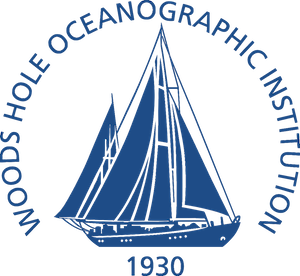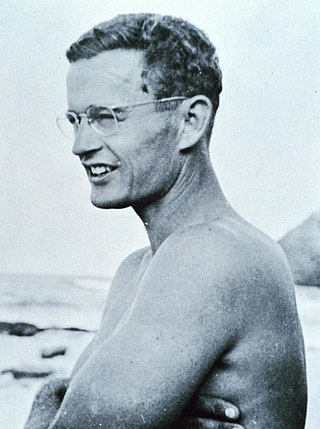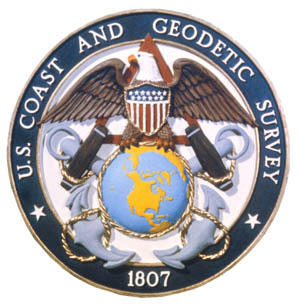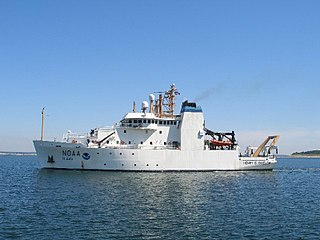
The National Oceanic and Atmospheric Administration is a US scientific and regulatory agency charged with forecasting weather, monitoring oceanic and atmospheric conditions, charting the seas, conducting deep-sea exploration, and managing fishing and protection of marine mammals and endangered species in the US exclusive economic zone. The agency is part of the United States Department of Commerce and is headquartered in Silver Spring, Maryland.

Oceanography, also known as oceanology, sea science, ocean science, and marine science, is the scientific study of the ocean, including its physics, chemistry, biology, and geology.

The Woods Hole Oceanographic Institution is a private, nonprofit research and higher education facility dedicated to the study of marine science and engineering.

Townsend Cromwell was an oceanographer who discovered the Cromwell current while researching drifting in the equatorial region of the Pacific Ocean. He died in an airplane crash, that of the Aeroméxico Flight 111 on 2 June 1958, which killed all 39 passengers and seven crew on board. The accident, also fatal to the American fisheries research biologist Bell M. Shimada, occurred near Guadalajara, Mexico, as the men were en route to join the Scot Expedition at Acapulco. Cromwell was Senior Scientist with the Inter-American Tropical Tuna Commission and Research Associate at Scripps Institution of Oceanography, La Jolla, California. His field of work was the physical environment and its relation to fisheries. He became a weather officer in the United States Army Air Forces during World War II. After receiving a B.A. degree from University of California in 1947, he returned to La Jolla, his boyhood home, as a student at Scripps, receiving an M.S. degree in oceanography from the University of California in 1949. At Scripps he was strongly influenced by the oceanographer H. U. Sverdrup.

The Office of Marine and Aviation Operations (OMAO) is a division of the National Oceanic and Atmospheric Administration (NOAA) which operates a wide variety of specialized ships and aircraft to carry out the environmental and scientific missions of NOAA.
George Washington Littlehales was an American oceanographer and civil engineer, known for his work with the United States Hydrographic Office.
USC&GS Discoverer was the name of two ships of the United States Coast and Geodetic Survey, and may refer to:
Two ships of the United States Navy have borne the name Thomas G. Thompson, in honor of oceanographer Thomas G. Thompson (1888–1961).
USC&GS Oceanographer was the name of two ships of the United States Coast and Geodetic Survey, and may refer to:

The United States Coast and Geodetic Survey was the first scientific agency of the United States Government. It existed from 1807 to 1970, and throughout its history was responsible for mapping and charting the coast of the United States, and later the coasts of U.S. territories. In 1871, it gained the additional responsibility of surveying the interior of the United States and geodesy became a more important part of its work, leading to it being renamed the U.S. Coast and Geodetic Survey in 1878.
NOAAS Discoverer may refer to the following ships of the National Oceanic and Atmospheric Administration (NOAA):

NOAAS Henry B. Bigelow is a fisheries research vessel operated by the United States' National Oceanic Atmospheric Administration (NOAA). She is the second in a class of five fisheries research vessels. She is named after Henry Bryant Bigelow (1879-1967), the American oceanographer, zoologist, and marine biologist who founded the Woods Hole Oceanographic Institution in Woods Hole, Massachusetts.

Karen Kohanowich is a retired U.S. Naval officer and ocean research and technology program manager for the National Oceanic and Atmospheric Administration (NOAA)'s Office of Ocean Exploration and Research (OER). She was NOAA's Acting Director of the National Undersea Research Program (NURP) from 2006 to 2009, and served in various roles at OER, including Acting Deputy and Undersea Technology director, until retiring in 2018. In July 2006, she became an aquanaut on the NASA Extreme Environment Mission Operations 10 crew.

NOAAS David Starr Jordan (R444)) was an American fisheries research vessel in commission in the National Oceanic and Atmospheric Administration (NOAA) from 1970 to 2010. She previously was in the United States Fish and Wildlife Service's Bureau of Commercial Fisheries fleet from 1966 to 1970 as US FWS David Starr Jordan.
The R101 was a British airship which crashed in 1930.

Timothy Cole Gallaudet is an American oceanographer and retired Rear Admiral in the United States Navy. Gallaudet worked for the U.S. Department of Commerce as the Acting Under Secretary of Commerce for Oceans and Atmosphere and Acting Administrator of the National Oceanic and Atmospheric Administration (NOAA). As of 2024 he is the CEO of Ocean STL Consulting, LLC., and hosts The American Blue Economy Podcast.

NOAAS Oceanographer, originally USC&GS Oceanographer, was an American Oceanographer-class oceanographic research vessel in service in the United States Coast and Geodetic Survey from 1966 to 1970 and in the National Oceanic and Atmospheric Administration (NOAA) from 1970 to 1996. She was the second Coast and Geodetic Survey ship and first NOAA ship to bear the name Oceanographer. She served as flagship of both the Coast and Geodetic Survey and NOAA fleets.

NOAAS Discoverer, originally USC&GS Discoverer, was an American Oceanographer-class oceanographic research vessel in service in the United States Coast and Geodetic Survey from 1966 to 1970 and in the National Oceanic and Atmospheric Administration (NOAA) from 1970 to 1996. She was the second Coast and Geodetic Survey ship and first NOAA ship to bear the name Discoverer.

NOAAS Oceanographer is an American oceanographic research vessel scheduled to enter commissioned service in the National Oceanic and Atmospheric Administration (NOAA) in 2025. She is under construction, with completion anticipated in early 2025. She is the second NOAA ship to bear the name Oceanographer.

NOAAS Discoverer is an American oceanographic research vessel scheduled to enter commissioned service in the National Oceanic and Atmospheric Administration (NOAA) in 2026. She is under construction, with completion anticipated in 2026. She is the second NOAA ship to bear the name Discoverer.
This page is based on this
Wikipedia article Text is available under the
CC BY-SA 4.0 license; additional terms may apply.
Images, videos and audio are available under their respective licenses.













